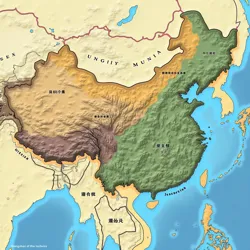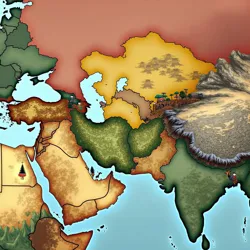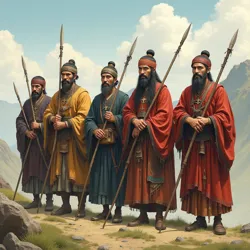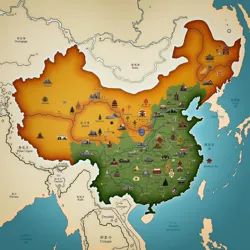Minority Ethnicities and Minor States of the Jade Lands

Depicted are various ethnic groups and political entities within the Jade Lands showcasing the region's cultural and social complexity
political fragmentation
cultural heterogeneity
different linguistic branches
western Shu-Han and Jin-Wei
live on boats
northeastern Liang-Ning
tribal alliance
The Jade Lands, characterized by their intricate tapestry of independent states and diverse cultures, are home to a wide array of minority ethnicities and minor political entities that exist alongside the nine major kingdoms. These groups, often residing in geographically peripheral or less resource-rich regions, contribute significantly to the overall cultural and social complexity of the Jade Lands. Their histories, languages, and customs, while sometimes less documented than those of the dominant cultures, are integral to understanding the multifaceted nature of this region. This article explores the diverse spectrum of minority ethnicities and minor states, examining their origins, their interactions with the major powers, and their unique place within the broader context of the Jade Lands.
Overview of Diversity in the Jade Lands
The Jade Lands, unlike many regions marked by large, centralized empires, have for centuries been defined by political fragmentation and cultural heterogeneity. This characteristic is not only evident in the existence of multiple major kingdoms like Liang-Ning and Yong-An, but also in the presence of numerous smaller ethnic and political groups. These minorities often occupy specific ecological niches or geographical areas that, for various historical and environmental reasons, have remained outside the direct control or cultural assimilation efforts of the major states. The rugged terrain of the western mountains, the isolated southern coasts, and the borderlands with the northern steppes have all served as refuges and cradles for distinct ethnic and political identities.
 Shown is the political fragmentation and cultural heterogeneity of the Jade Lands with smaller ethnic and political groups alongside major kingdoms
Shown is the political fragmentation and cultural heterogeneity of the Jade Lands with smaller ethnic and political groups alongside major kingdomsEthnic and Linguistic Mosaic
The ethnic landscape of the Jade Lands is as varied as its geography. While the majority populations of the major states share a common ancestral stock and speak languages belonging to the Zhongyuan language family, numerous minority ethnicities speak languages from different linguistic branches or even entirely separate language families. These linguistic islands reflect historical migrations, pre-existing populations that were not fully absorbed by the expansion of the Zhongyuan cultural sphere, or groups that deliberately maintained their linguistic distinctiveness as a marker of ethnic identity. The Zhongyuan Language Family article details the diversification from Proto Zhongyuan, but this article will highlight groups outside of that linguistic sphere.
For instance, in the mountainous regions bordering the Samarkand Sultanate to the west, one finds communities speaking languages with closer affinities to Tibeto-Burman or even Altaic language families, suggesting ancient migrations from Central Asia or the Tibetan Plateau. Along the southern coasts, some groups speak languages with Austronesian influences, hinting at historical maritime interactions with peoples further to the south and east. These linguistic minorities often also maintain distinct cultural practices, religious beliefs, and social structures that differentiate them from the dominant Concordian Way-influenced cultures of the major states.
Political Fragmentation and Minor Polities
The political map of the Jade Lands is not simply composed of the nine major states. Scattered across the region are numerous minor polities, ranging from small-scale tribal confederations to more structured autonomous regions or protectorates. These minor states often exist in a complex relationship with the major kingdoms, sometimes paying tribute or acknowledging nominal suzerainty while maintaining a significant degree of internal autonomy. Others exist in more precarious situations, caught between the competing ambitions of larger states, or eking out an independent existence in remote or inaccessible territories.
The formation of these minor states is often linked to the same factors that fostered ethnic diversity: geographical isolation, resistance to assimilation, and the strategic advantages of marginal environments. Mountainous regions, dense forests, and coastal islands can provide natural defenses against external control, allowing smaller groups to develop their own political institutions and maintain their independence. Furthermore, the very fragmentation of the Jade Lands political landscape has, at times, created opportunities for minor states to play major powers against each other, or to exploit niches in trade and resource extraction that are less attractive to larger kingdoms.
Minority Ethnic Groups
The Jade Lands are populated by a diverse range of ethnic groups, each with unique cultural traits and historical experiences. While the major states are predominantly inhabited by groups speaking languages from the Zhongyuan language family, significant minority populations maintain distinct ethnic identities, languages, and customs. These groups can be broadly categorized based on their geographical distribution and historical origins, although such classifications are inherently simplified and do not fully capture the complex realities of ethnic identity and interaction.
 Illustrates the diverse range of ethnic groups in the Jade Lands highlighting their unique cultural traits and historical experiences
Illustrates the diverse range of ethnic groups in the Jade Lands highlighting their unique cultural traits and historical experiencesHighland Peoples of the West
The rugged western mountains, forming a natural barrier between the Jade Lands and the Islamic polities to the west, are home to a variety of highland peoples. These groups, adapted to the challenging mountain environment, often practice forms of pastoralism, forestry, and small-scale agriculture suited to the steep terrain and colder climate. Historically, their isolation and martial traditions have allowed them to maintain a degree of autonomy from the lowland states, although they have also been involved in trade and occasional conflicts with their more powerful neighbors.
The Rong People
The Rong people (戎族, Róng Zú) are one of the most prominent highland ethnic groups in the western Jade Lands. Residing primarily in the mountainous regions of western Shu-Han and Jin-Wei, the Rong are known for their distinct language, customs, and traditions. Their language, Rongish, is believed to belong to a separate branch of the Sino-Tibetan language family, exhibiting significant differences from the Zhongyuan language family. Historically, the Rong were organized into numerous independent tribes and chiefdoms, often engaging in raiding and trade with the lowland states. They were renowned for their horsemanship, archery skills, and knowledge of mountain warfare. While some Rong groups have been gradually integrated into the larger kingdoms over time, many continue to maintain their distinct cultural identity and a degree of political autonomy, particularly in the more remote mountain valleys. Their culture is rich in oral traditions, intricate textile weaving, and unique forms of music and dance that reflect their mountain environment and history of independence.
The Di People
Another significant highland group are the Di people (氐族, Dī Zú), who inhabit the mountainous areas further north, primarily in the border regions between Liang-Ning and Jin-Wei. Like the Rong, the Di are believed to have ancient roots in the western highlands, predating the expansion of the Proto Zhongyuan speaking populations. Their language, Diic, is even more linguistically isolated, with uncertain affiliations, though some scholars speculate connections to extinct language families of Central Asia. Historically, the Di were known for their metallurgy skills, particularly in copper and bronze, and their control of important mountain passes and trade routes. They often served as intermediaries in trade between the Jade Lands and the regions further west. Politically, the Di were less centralized than the Rong, typically organized into smaller, more fragmented tribal groups. Their cultural practices include distinctive forms of shamanism and animistic beliefs, as well as unique styles of clothing and ornamentation adapted to the colder mountain climate.
Coastal Communities of the South
The southern coasts of the Jade Lands, encompassing the states of Min-Yue and Wu-Yue, are home to a variety of coastal communities that have historically engaged in maritime activities and developed distinct cultural adaptations to the marine environment. While the majority populations of Min-Yue and Wu-Yue speak languages from the Zhongyuan language family, these coastal regions also harbor minority groups with closer ties to the sea and different cultural origins.
The Yue Islanders
Scattered across the numerous islands off the coast of Min-Yue and Wu-Yue are the Yue Islanders (島嶼越人, Dǎoyǔ Yuèrén), who represent a distinct ethnic group with a long history of maritime adaptation. While linguistically influenced by Minyue and Wuyuese, the Yue Islanders retain elements of older Austronesian languages in their vocabulary and grammar, suggesting ancient migrations from island Southeast Asia. Their traditional livelihoods are based on fishing, seafaring trade, and pearl diving. Yue Islander communities are typically smaller and more dispersed than mainland populations, organized into village-based societies with strong maritime traditions. They are renowned for their boat-building skills, navigational expertise, and deep knowledge of marine environments. Culturally, Yue Islanders often exhibit a more relaxed social structure and a greater emphasis on communal cooperation in maritime activities. Their religious beliefs often incorporate elements of sea worship and ancestor veneration, reflecting their close relationship with the ocean.
The Danjia Boat Dwellers
Another unique coastal minority group are the Danjia boat dwellers (蜑家, Dànjiā), sometimes referred to as "sea gypsies" of the Jade Lands. Traditionally living entirely on boats, the Danjia are found in coastal areas throughout Min-Yue, Wu-Yue, and even Jing-Hua. Their origins are debated, with some theories suggesting they are descended from marginalized coastal populations or migrants from further south. The Danjia speak a dialect of Jinghuanese with significant lexical borrowings from various maritime languages, reflecting their long history of seafaring and trade. Their lives are entirely oriented around the sea, with fishing, coastal trade, and maritime labor as their primary occupations. Danjia communities are highly mobile and adaptable, moving with the seasons and following fishing patterns. Their social structure is egalitarian and community-oriented, with strong traditions of maritime cooperation and mutual support. Due to their nomadic lifestyle and marginalized status, the Danjia often face discrimination and limited access to land-based resources and services, leading to ongoing challenges in their integration with mainstream society.
Steppe Borderland Groups
Along the northern borders of Liang-Ning and Yan-Zhao, where the Jade Lands transition into the vast steppes, a different set of minority groups exists, reflecting the long history of interaction and exchange between agricultural and nomadic societies. These groups often exhibit cultural and linguistic influences from both the Jade Lands and the steppe peoples to the north, creating a unique borderland identity.
The Xianbei Descendants
In the northeastern border regions of Yan-Zhao, remnants of Xianbei (鮮卑, Xiānbēi) groups can still be found. Historically, the Xianbei were a major nomadic confederation that exerted significant influence in this region centuries ago. While largely assimilated into the dominant cultures of the Jade Lands over time, some communities in remote areas have preserved aspects of Xianbei language and culture. Their language, Xianbeic, is an Altaic language, distantly related to Turkic and Mongolian languages. These groups often maintain traditions of horsemanship, archery, and pastoralism, alongside agriculture and trade. Their social structure may retain elements of tribal organization, and their cultural practices may include unique forms of music, dance, and clothing that reflect their steppe heritage. They often serve as cultural bridges between the Jade Lands and the nomadic peoples of the north, facilitating trade and cultural exchange.
The Qiang Migrants
Further west, along the northern borders of Liang-Ning and Jin-Wei, communities of Qiang Migrants (羌族移民, Qiāngzú Yímín) are found. The Qiang are an ancient ethnic group with origins in the western highlands, related to both the Rong and Di peoples. Over centuries, various Qiang groups migrated eastward and northward, often becoming integrated into the borderland regions. Their language, Qiangic, is Tibeto-Burman, related to Rongish but distinct from the Zhongyuan language family. Qiang communities in the borderlands often practice a mix of agriculture, pastoralism, and trade, adapting to the varied environments of the steppe-forest transition zone. They are known for their resilience, adaptability, and strong community bonds. Culturally, Qiang groups often maintain unique forms of ancestor veneration, shamanistic practices, and distinctive styles of clothing and ornamentation. They play a significant role in the borderland economy and culture, often acting as intermediaries between the Jade Lands states and the nomadic groups further north and west.
Minor States and Autonomous Regions
Beyond the major kingdoms, the Jade Lands are dotted with numerous minor states and autonomous regions. These polities vary significantly in size, structure, and degree of independence, reflecting the complex political landscape and historical contingencies of the region. Some are remnants of once-larger entities, while others emerged from tribal confederations or through strategic maneuvering in the spaces between major powers.
 Displayed are the various minor states and autonomous regions scattered across the Jade Lands reflecting the complex political landscape
Displayed are the various minor states and autonomous regions scattered across the Jade Lands reflecting the complex political landscapeThe Dongsheng Protectorate
The Dongsheng Protectorate (東勝都護府, Dōngshèng Dūhùfǔ) is a minor state located in the remote and mountainous regions of northeastern Liang-Ning, bordering Yan-Zhao and the northern steppes. Established centuries ago by a coalition of local tribes and dissident Liangningese nobles, the Dongsheng Protectorate has maintained a precarious independence by leveraging its rugged terrain and strategic location. Nominally a protectorate under Liang-Ning suzerainty, in practice, Dongsheng enjoys near-complete autonomy in internal affairs and a significant degree of control over its external relations. Its economy is based on mining (particularly iron and jade), forestry, and trade with both Liang-Ning and steppe groups. The Dongsheng Protectorate is known for its unique blend of Liangningese and steppe cultures, its martial traditions, and its distinctive form of Concordian Way practice, which incorporates elements of shamanism and ancestor worship. The protectorate is ruled by a hereditary chieftain council, drawn from the leading families of the constituent tribes, who elect a paramount chief to represent them in external affairs. The Dongsheng Protectorate exemplifies a minor state that has successfully navigated the complex political landscape of the Jade Lands by maintaining a strategic balance between larger powers and exploiting its geographical advantages.
The Mengshan Confederation
The Mengshan Confederation (蒙山聯盟, Méngshān Liánméng) is a loose alliance of tribal groups residing in the densely forested Meng Mountains, located in the southern part of Qi-Lu and Jin-Wei. Unlike a centralized state, the Mengshan Confederation is a decentralized network of autonomous tribes, bound together by shared cultural traditions, mutual defense agreements, and periodic assemblies. The tribes of the Mengshan Confederation are primarily engaged in forestry, hunting, and gathering forest products, with limited agriculture in the valleys. They are known for their deep knowledge of the forest environment, their skilled hunters and trackers, and their resistance to external encroachment. While nominally acknowledging the authority of Qi-Lu and Jin-Wei, the Mengshan tribes effectively control their own territories and resources within the mountains. The confederation is governed by a council of tribal elders, who meet periodically at a sacred site in the mountains to resolve disputes, coordinate defense, and conduct inter-tribal rituals. The Mengshan Confederation represents a form of stateless society that has persisted in a geographically marginal and defensible environment, maintaining its autonomy through decentralized organization and a strong collective identity.
The Shanyue Tribal Territories
The Shanyue Tribal Territories (山越部落領地, Shānyuè Bùluò Lǐngdì) encompass a patchwork of independent tribal groups scattered across the mountainous regions between Wu-Yue, Min-Yue, and Jing-Hua. The Shanyue, meaning "mountain Yue," are descendants of indigenous Yue peoples who resisted assimilation by the expanding Zhongyuan cultural sphere. They are not unified under a single political entity but rather consist of numerous autonomous tribes and clans, each with its own territory, leadership, and customs. The Shanyue tribes are adapted to the mountainous terrain and forested environment, practicing swidden agriculture, hunting, and gathering forest products. They are known for their fierce independence, their guerilla warfare tactics, and their resistance to external control. The major states of Wu-Yue, Min-Yue, and Jing-Hua have historically attempted to exert influence over the Shanyue, sometimes through military campaigns, sometimes through trade and diplomacy. However, the rugged terrain and decentralized nature of Shanyue society have made it difficult for any state to fully subdue or integrate them. The Shanyue Tribal Territories represent a zone of persistent tribal autonomy within the Jade Lands, characterized by ongoing interactions and tensions with the surrounding states.
Interactions and Integration
The relationship between minority ethnicities, minor states, and the major powers of the Jade Lands is complex and multifaceted, ranging from conflict and subjugation to cooperation and cultural exchange. These interactions have shaped the cultural landscape of the region and continue to influence its dynamics in the modern era.
Cultural Exchange and Syncretism
Despite political divisions and occasional conflicts, cultural exchange and syncretism have been ongoing processes in the Jade Lands. Minority ethnic groups and minor states have often adopted elements of the dominant cultures, particularly the Concordian Way and aspects of Zhongyuan language family languages, while simultaneously preserving their own unique traditions. Trade, migration, and intermarriage have facilitated the flow of ideas, technologies, and cultural practices across ethnic and political boundaries. For example, Rong and Di artisans in the western highlands have incorporated Jade Lands artistic styles into their crafts, while also influencing lowland metalworking and textile traditions with their own techniques. Yue Islander maritime expertise has been adopted by Jing-Hua and Min-Yue shipbuilders, while Yue Islander culture has in turn been influenced by mainland religious and social customs. This dynamic exchange has resulted in a rich tapestry of syncretic cultures across the Jade Lands, where distinct ethnic and regional identities are interwoven with shared cultural elements.
Political Relations and Autonomy
The political relationship between minor states and major kingdoms is often characterized by a delicate balance between autonomy and dependence. Minor states may pay tribute or acknowledge nominal suzerainty to larger powers in exchange for protection, trade privileges, or non-interference in internal affairs. Strategic alliances and shifting power dynamics can allow minor states to maintain or even enhance their autonomy by playing major powers against each other. However, minor states also face the constant threat of encroachment or annexation by larger, more ambitious kingdoms. The history of the Jade Lands is replete with examples of minor states being absorbed by larger entities, or successfully resisting such absorption through skillful diplomacy, military prowess, or geographical advantages. The Dongsheng Protectorate and the Mengshan Confederation exemplify different strategies for maintaining political autonomy in the shadow of larger states, highlighting the diverse political landscape of the Jade Lands.
The Concordian Way and Minority Groups
The Concordian Way, while originating in the central plains and associated with the dominant cultures of the major states, has also spread and adapted among minority ethnic groups and minor states. The emphasis on harmony, ancestral veneration, and moral cultivation resonates with many cultural traditions across the Jade Lands, providing a common spiritual framework despite ethnic and political differences. However, minority groups often interpret and practice the Concordian Way in unique ways, incorporating elements of their own indigenous beliefs and rituals. In some cases, minority groups have even developed distinct sects or schools within the Concordian Way, reflecting their specific cultural and historical contexts. The Mount Hua Holy See, while seeking to promote a unified Concordian Way orthodoxy, has also shown a degree of flexibility in accommodating regional and ethnic variations in religious practice, recognizing the diverse expressions of spirituality within the Jade Lands.